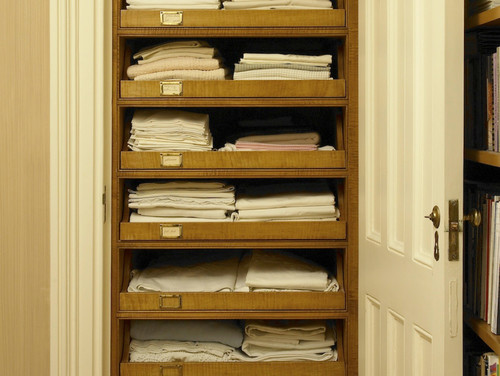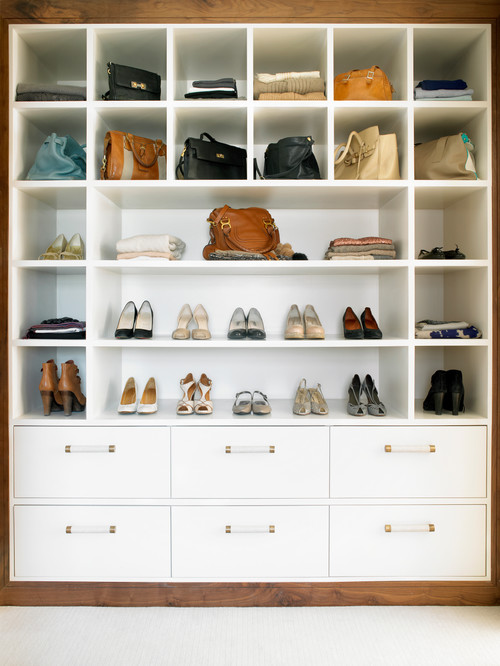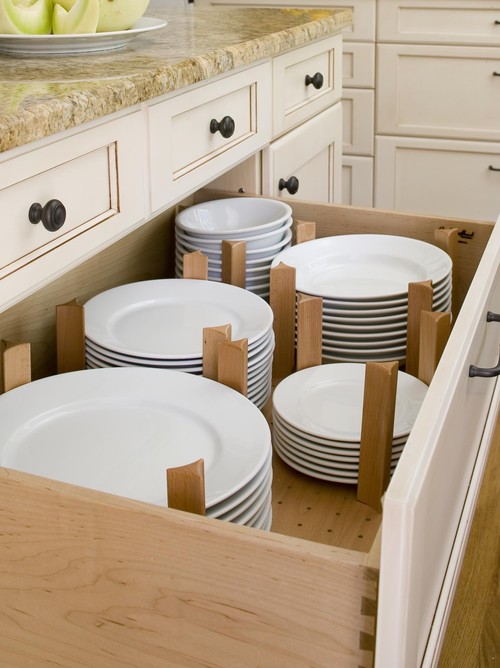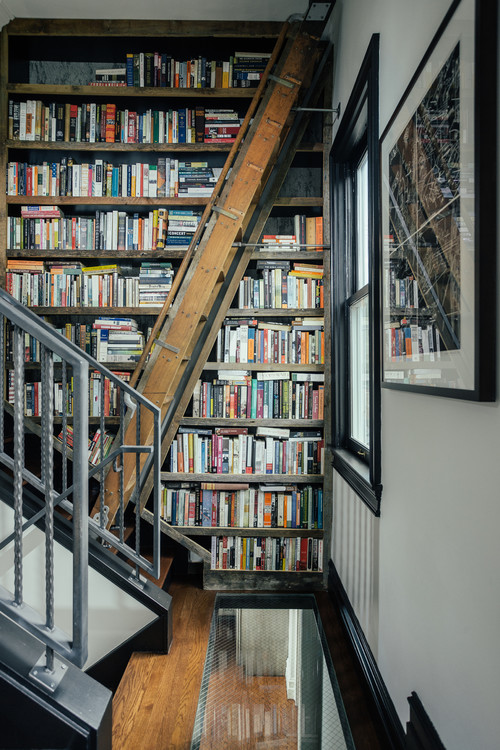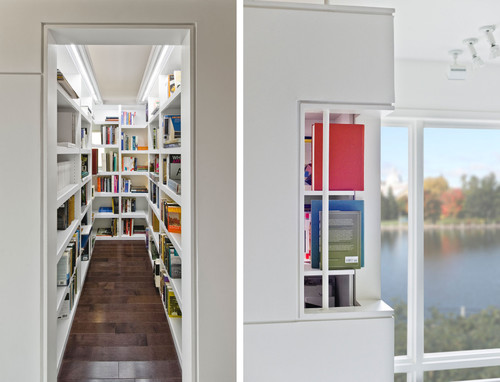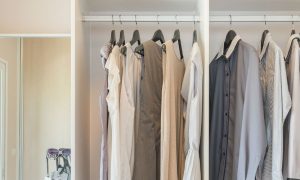Houzz Contributor, Laura Gaskill
So you want to pare down your belongings. But how much, exactly, do you get rid of? And how can you prevent stuff from simply piling up all over again? Part of the solution to a lasting clutter-free existence may lie in numbers. As in, the number of pairs of shoes, towels, place settings and so on that you decide to keep in the house. By deciding how many items in each category of stuff you really need, those numbers become a sort of fail-safe, preventing your home from free-falling into its formerly cluttered state. Check out these ideas on how to get started, then share your own numbers in the Comments.
The “sometimes” dilemma: What to do if you use something but only occasionally? Fancy china and highly specialized cookware come immediately to mind. If you really do love to have these things when the occasion calls for it, and you have storage space for them, by all means keep them. Just be intentional about what and how much you are keeping, and know why. Try to avoid keeping large sets of anything purely out of guilt — if you’ve inherited something you don’t want, see if someone else in the family wants it, sell it or donate it to charity.
More tips on what to do with sentimental pieces
How much to keep? Set a space limit. One way to keep rarely used items in check is to limit the amount of storage space you afford them. Instead of allowing your entertaining arsenal to multiply indefinitely over time, taking over not only cupboards but basement shelves and the attic too, decide on one space to store these items in and stick with it. For instance, keep all china in one nice china hutch — if you acquire more down the road, give away or sell something to free up space.
The Rule of Three: One in the wash, one in the cupboard, one in use. You may have heard this one before, but it bears repeating because it really works. It can be difficult to come up with what seems to be a rather arbitrary number of items to keep, but sticking with one for the shelf, one to use and one to wash keeps things simple. I follow this rule for sheets (per bed) and towels (per person).
What about guests? Unless you are running a boarding house, two sets of sheets for each guest bed and two sets of towels per guest are plenty.
The seasonal exception: Even minimalists may want to keep extra stuff on hand to rotate in depending on the season — and that’s whether or not there are chilly winters.
It can be a nice change of pace to bring out thicker blankets in warmer hues for the winter and light, airy linens in summer. But that doesn’t necessarily mean you should double the number of sets you have, if some sets work well year-round. For instance, you could decide to keep one set of sateen sheets for year-round use, two sets of flannels for winter and two cool, crisp sets for summer.
Special case: Clothes. Clothes and shoes may be the most personal (and difficult) category of stuff to put limits on. That said, even those with intense attachments to their wardrobes can find it worthwhile to do a proper inventory.
After figuring out that you actually have 100 pairs of shoes or 20 nearly identical black tops, you may decide to bring that number down … or you may not, but at least you will be informed.
Special case: Kids’ stuff. When a child’s room is overflowing with stuff, it’s hard to focus on any one thing, and pretty soon all of those lovingly chosen toys become just part of the mess. Setting space constraints is a smart way to handle this situation. Dedicate certain shelves, plus perhaps a toy closet (for toys not currently being used in the rotation) for your child’s belongings, and keep it at that. When a bin or shelf begins to overflow, or you notice that stuff is piling up on the floor (because it has nowhere else to go), take that as a cue to give something away.
The everyday stuff: Count it out. Do you know how many basic plates, bowls, cups and wineglasses you own? If you’re not sure, go count them — you may be surprised at just how many pieces of “everyday” tableware you have. Of course it’s nice to have enough of everything that the whole household can eat a meal or two and not worry about getting everything washed and dried, and you’ll want extras on hand for bigger casual dinners with family and friends if you host that sort of thing, but you won’t likely need more than that.
Not everyone wants to stick with one set of white dishes (although for simplicity’s sake, that’s surely an easy way to go). But you can still set a limit at a certain number of sets. If you go over your number, it’s time to start culling.
Special case: Tupperware. What is it about plastic containers that makes them seem to multiply when you’re not looking (but hardly ever with a matching lid)? Start by removing any lids that don’t have mates, then count what you have left. Most of us probably have too many food storage containers — really, how many leftovers are you likely to wrap up at any given time? Three? Four?
Special case: Your passions. Book lovers, athletes, outdoorsy types, musicians, crafters … you know who you are. And more important, you know how easy it is to collect more and more stuff to support your passion.
Being aware of exactly what you already own is a good first step toward reining in your collections — perhaps your yarn stash is in such disarray, you end up buying yarn you already have.
But it’s also a good idea to start paying attention to what you actually use. If you treasure your books, notice which ones you actually pick up from time to time — I realized a while ago that I rarely pick up novels after I’ve read them, so I decided to let go of most books in that category.
Pain-free ways to declutter your library
Just because you have the room to store it doesn’t mean you should. Extra space is deceptive. If you are blessed with large closets and ample storage space, you may be thinking you’re off the hook — but the truth is, everyone can benefit from paring down a little. Having fewer belongings means less time spent cleaning, moving and mending them; less time looking for things; and generally less to worry about. And if you ever need to downsize in the future, the process will be far less gut wrenching if you have already chosen to live with less stuff.
Set your own rules. The point of this ideabook is to help you gain awareness of what kind of and how much stuff you need, so you can tailor your stuff to fit your life. And no one else can really do that for you. It may take a while to figure out exactly the right amount of stuff for you, but once you do, it’s bound to make your life a little easier.
Tell us: What are your numbers? How many sets of sheets, dishes or pairs of shoes are enough for you?
Related Reads
Keep All Fancy Dinnerware in a China Cabinet
Dedicate a Toy Box for All the Kids’ Stuff
Get Help From Local Professional Organizers



